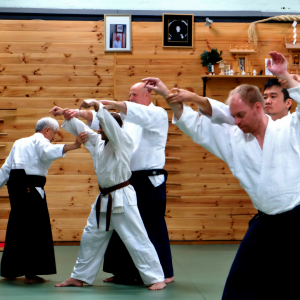Looking for Interesting Background Knowledge on Aikido
In order to really understand Aikido, it is good to have some background knowledge of the history of the artform. As a more recent martial art, Aikido’s history and growth has luckily been able to be comprehensively documented. Many figures, most notably Stanley Pranin went to great efforts to gather first person accounts as well as records in general. What is evident from the primary resources is an interesting and mottled history. Eushiba’s life (the founder is an extraordinary one) from being a pioneer on the frontiers of desolate northern Japan, to exploring his spirituality in Shinto sects and then trying to leave them and finally, dealing with family drama and politics within his own emerging martial art. This all takes place as well over the backdrop of the historical currents of Japan’s place on the world stage during the 20th century.
What is interesting to note from this mottled history and has remained a great point of contention is what is Aikido or Eushiba’s Aikido? When O’sensei died, he did not leave much of a structure or curriculum to the artform. Moreover, his artform continually developed as he aged. From this, many of his head students had to pick up the pieces after sensei passed on, and try to make sense of what O’sensei was teaching and create a curriculum. A curriculum is a challenging thing to structure; part of it is having a set of stock techniques taught and then secondly as well, ensuring that as students progressed through the ranks, that there are concepts clearly evident and built on through these techniques. This makes a curriculum very personal in that the choice of what concepts/techniques present in the curriculum suggest what is most valued by the creator of that curriculum. Partly because of this open-ended interpretation of what the curriculum should be, many styles have emerged.
Should we even be concerned with delineation – does it even matter that our style is different from others? With so many abundant styles it becomes questionable to ask how should we be training and moreover why is our style the way it is. Understanding the history of Aikido and the branches that have spread forth allows us to figure out why our style is what it is and in turn what we should be aiming for in our own training.
If you are really interested in such matters, a blog article by Mark Murray is worth a read: https://www.aikidosangenkai.org/blog/ueshiba-legacy-mark-murray/
The article is from a blog that puts forward a strong case that aikido changed from what Eushiba intended. I will say the author does favour internal power ideas but it is still worth a read.
Chris Cobbo





 Man is most humbled through a culture that has a respect for all things.
Man is most humbled through a culture that has a respect for all things.









